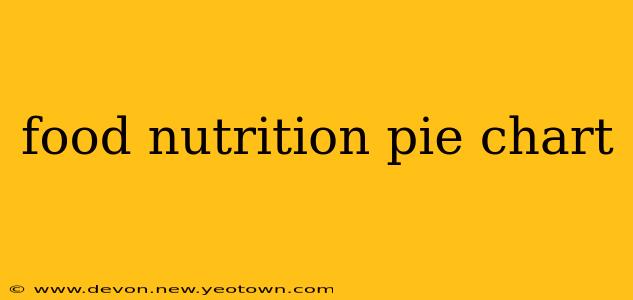Imagine a delicious, perfectly baked pie. But instead of apple or cherry filling, this pie represents your daily food intake. This is the essence of a food nutrition pie chart – a visual representation of the ideal proportions of different food groups you should consume each day to maintain a healthy and balanced diet. Understanding this chart isn't about strict adherence to percentages, but rather a helpful guide to make informed choices about what lands on your plate. Let's slice into the details.
What is a Food Nutrition Pie Chart?
A food nutrition pie chart is a circular diagram divided into segments, each representing a different food group (fruits, vegetables, grains, protein, and dairy). The size of each segment reflects the recommended proportion of that food group in your daily diet. It's a simplified, easy-to-understand tool to visualize the principles of healthy eating. Think of it as a roadmap to nourishing your body effectively.
My journey into understanding nutrition started with a rather confusing array of dietary guidelines. It felt like deciphering a secret code! Then, I discovered the power of the pie chart. It transformed the complex world of nutrition into something manageable and visually appealing. Suddenly, balancing my meals became less daunting.
What are the Main Food Groups in a Nutrition Pie Chart?
While specific proportions can vary based on individual needs, age, and activity levels, most food nutrition pie charts generally include these key food groups:
1. Fruits and Vegetables: The Colorful Cornerstones
This segment is usually the largest, emphasizing the importance of these nutrient powerhouses. Fruits and vegetables are packed with vitamins, minerals, and antioxidants, crucial for boosting immunity and overall health. Aim for a variety of colors – the more vibrant your plate, the more diverse your nutrient intake! Remember, a daily apple keeps the doctor away, and other colorful fruits and veggies keep you vibrant too!
2. Grains: The Energy Engine
This section represents whole grains like brown rice, quinoa, oats, and whole-wheat bread. These provide sustained energy, fiber for digestion, and essential nutrients. Refined grains like white bread and pastries should be consumed sparingly. My personal shift towards whole grains drastically improved my energy levels.
3. Protein: The Building Blocks
This segment highlights lean protein sources like fish, chicken, beans, lentils, and tofu. Protein is essential for building and repairing tissues, supporting muscle growth, and maintaining healthy immune function. Finding a balance of plant-based and animal-based proteins is ideal.
4. Dairy (or Dairy Alternatives): The Calcium Champions
This section represents dairy products like milk, yogurt, and cheese, or plant-based alternatives like almond milk and soy yogurt. These are crucial for calcium intake, vital for strong bones and teeth. Choosing low-fat options is usually recommended.
5. Fats: The Often Misunderstood
While often overlooked, fats play a crucial role in overall health. This segment usually includes healthy fats like avocados, nuts, seeds, and olive oil. These provide essential fatty acids that support brain function, hormone production, and cell growth. Limit saturated and trans fats found in processed foods.
How Can I Use a Food Nutrition Pie Chart?
A food nutrition pie chart isn’t a rigid rulebook; it's a flexible guide. Use it as a framework to:
- Plan your meals: Before grocery shopping, visualize your ideal pie chart and plan meals accordingly.
- Assess your current diet: Analyze your usual food intake and compare it to the ideal proportions. This can highlight areas for improvement.
- Make healthier choices: Use the chart to guide your food selections when eating out or making quick meals.
- Educate yourself and others: Share the pie chart with family and friends to promote healthy eating habits within your community.
What are the potential drawbacks of using a food nutrition pie chart?
While helpful, a pie chart offers a simplified view of nutrition. It doesn't account for individual caloric needs, specific micronutrient requirements, or the complex interplay of various nutrients. It's vital to consult a registered dietitian or healthcare professional for personalized dietary advice.
Can I create my own food nutrition pie chart?
Absolutely! Many online tools and templates allow you to customize a pie chart based on your specific dietary needs and preferences. This personalized approach can make the process more engaging and effective.
By understanding and utilizing the food nutrition pie chart, you can embark on a journey towards a healthier and more balanced lifestyle. Remember, it’s about progress, not perfection! Embrace the process, experiment with different foods, and enjoy the delicious path to better health.

